Hatem Ben Arfa was described as a ‘football genius’ by new Girondins de Bordeaux manager Jean-Louis Gasset when the playmaker joined the Ligue 1 side on a free transfer ahead of the 2020/21 campaign. We’re now beyond the midway point of the season, and you could argue that the 33-year-old has lived up to that billing.
He is the third-oldest player in a Bordeaux squad that is, on average, the joint-second oldest squad in Ligue 1 (27.7). However, it seems like nobody has informed Ben Arfa of this from the performances he’s been producing on the pitch.
Despite enduring a disappointing 2019/20 season, the first half of which he spent without a club and the second half of which he spent in La Liga with Real Valladolid, where he made just five appearances and failed to provide a single goal contribution, Gasset was full of praise for Ben Arfa when he signed him, while Ben Arfa was also complimentary about his new coach, explaining that he was attracted to Bordeaux by his football philosophy. So, it seems like it may have been a case of ‘love at first sight’ for Gasset and Ben Arfa, but what is for sure is that the 67-year-old coach has managed to get Ben Arfa producing some impressive football.
In this tactical analysis piece, we’ll provide some analysis of just why Ben Arfa has been so useful for Les Girondins this season in the form of a scout report. We’ll look at his role within Gasset’s tactics and how it has brought the best out of him, by making the most of his most remarkable traits on the pitch.
Positioning
Bordeaux has primarily utilised a 4-2-3-1 shape this term. Ben Arfa tends to occupy the ‘number 10’ role within that system, just behind the centre-forward – typically Hwang Ui-jo – and in front of the double-pivot – usually, Toma Bašić and Otávio.
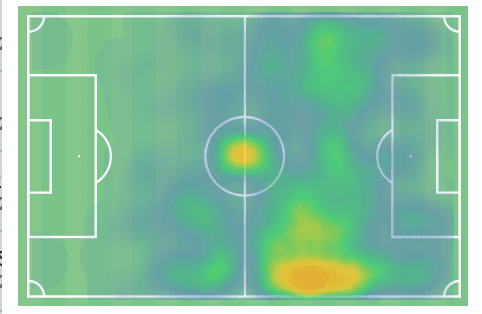
The image above shows us Ben Arfa’s heatmap for the 2020/21 campaign, and this tells us more about the attacking midfielder’s specific role within Gasset’s tactics.
While Ben Arfa usually plays as the ‘number 10’ in this system, he doesn’t just play in central zones. Ben Arfa enjoys a remarkably free role, in possession, within this system, which sees him pop up on the left-wing, right-wing, deeper positions and everywhere in between.
We can see that he does tend to spend a lot of his time on the right-wing, as well as in and around the centre-circle. However, there is plenty of colours scattered all over the heatmap here, which backs up the point that he enjoys a lot of freedom of movement under Gasset.
This system’s role allows him to use his intelligence, vision, and off the ball movement to find space all across the central/final third. After exploiting that space and receiving the ball, he typically utilises his dribbling quality to progress the play further, probing into the opposition’s penalty area.
As a result of his free movement, Ben Arfa attacks the penalty box from various positions during the game, asking different questions of the opposition defence throughout the contest.
Movement
Ben Arfa’s off the ball movement is a pivotal aspect of his game as we touched on above. It’s arguably been one of the main reasons that he has enjoyed such an impressive campaign. He’s exhibited a great deal of intelligence to find space off the ball throughout the 2020/21 campaign, while Gasset has put him in a position to use his ability to find space, by handing him so much positional freedom within his side.
In this section, we’ll analyse different examples of Ben Arfa’s off the ball movement creating danger for the opposition and helping his side to progress play.
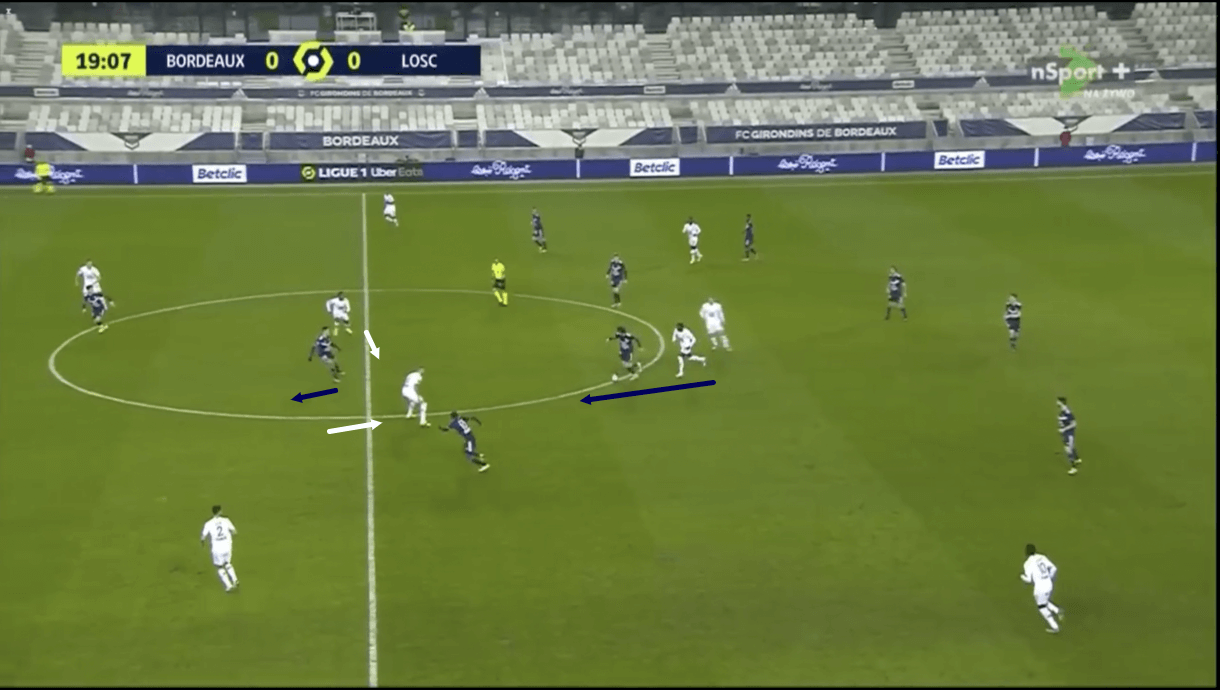
In this next image above, Ben Arfa can be seen inside the centre-circle. We already established an area where he likes to spend an incredibly significant amount of time looking at his heatmap.
Ben Arfa’s movement into different areas of the pitch has indeed been a great asset for his side this term, however, as this image above illustrates, much of the time he finds the most space by simply standing still.
He often picks up a position in the very centre of the pitch and allows the other players to move about all around him, freeing himself up as a result.
In this image, we can see Bordeaux on the counter-attack, and as the ball is being carried out of their own half, the man in possession attracts some opposition players towards him. As those players get drawn towards the man in control, Ben Arfa begins to ease back ever so slightly, opening his body to receive the ball on the half-turn and quickly carry it onwards towards the penalty box.
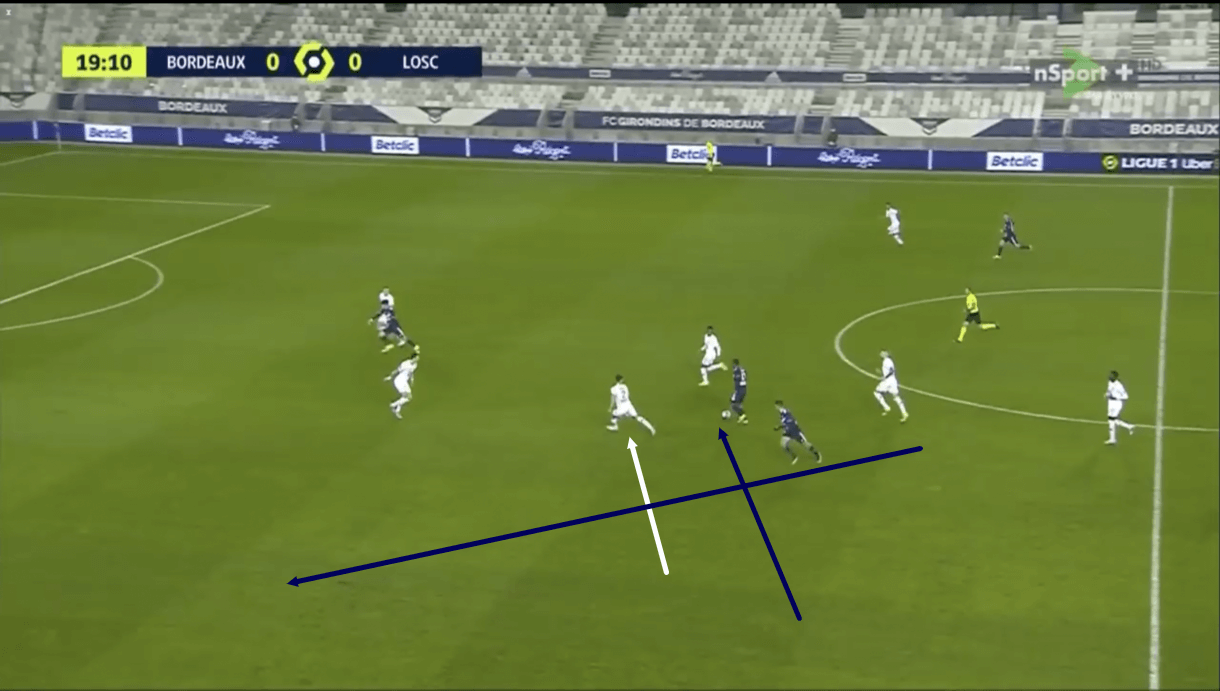
As the play moves on, however, Ben Arfa doesn’t actually end up receiving possession. Instead, Samuel Kalu picks up the ball, as he moves inside from the left-wing. As the left-winger comes inside, he drags the opposition right-back with him, and this creates space out on Bordeaux’s left-wing, which, as the image above shows, Ben Arfa spots and heads straight towards, to try and exploit that free space.
This play passage provides us with a good example of how Ben Arfa’s free role in possession works in Gasset’s system, and how effective the Frenchman is at scanning his surroundings and probing into space wherever it is available.
These are the kinds of movements that you see Ben Arfa always make throughout a given game. He often gets the ball in space in these areas, from where it becomes much easier for him to utilise his dribbling quality. So, we can see how he has helped himself make such an impact for Bordeaux this season via his movement from bits of play like this.
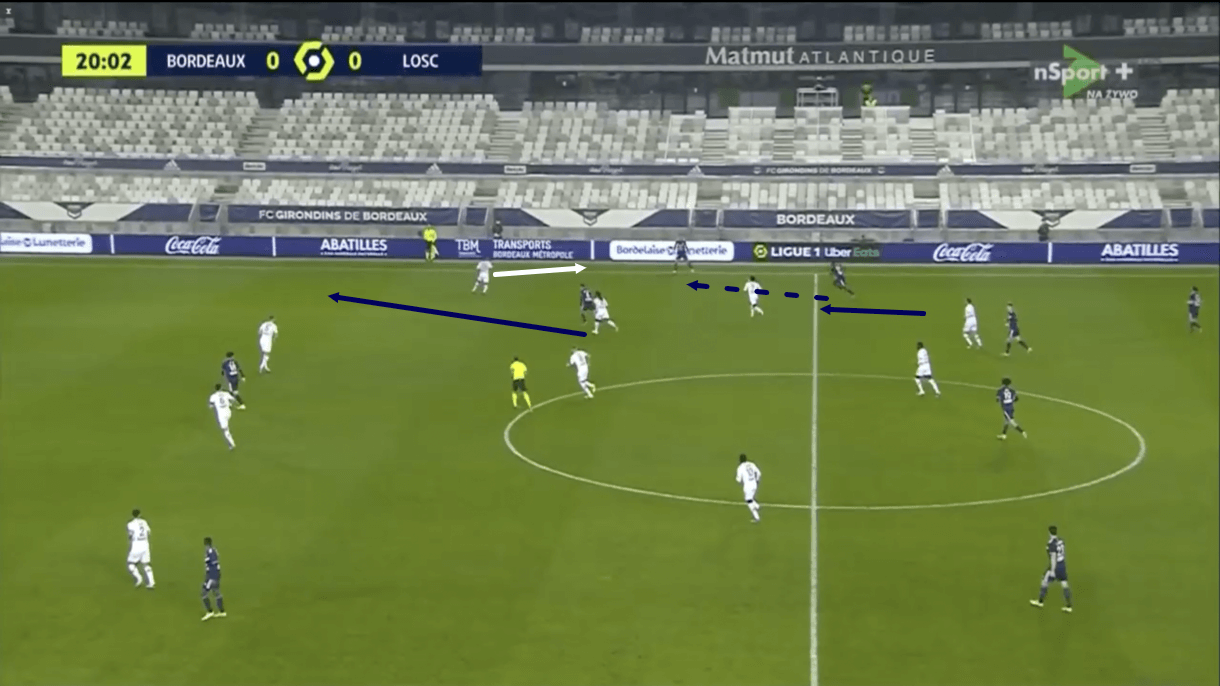
This next image shows us another example of Ben Arfa drifting out wide from his central position to exploit space as it opens up. Here, Bordeaux’s right-back has just carried the ball out from the back and played it onto the right-winger. As the right-winger receives the ball, he attracts pressure from the opposition left-back, and as we can see, Ben Arfa spots this and sets off on his run.
As the left-back approaches the right-winger, space opens up in behind him and between him and the left centre-back. Ben Arfa drives into this space, making himself available for the through ball that inevitably comes his way from the right-winger.
This passage of play shows us how Ben Arfa’s movement from the centre out to the wing helps his side create a vast overload, when combining with the winger and full-back, to progress the ball into the final third.
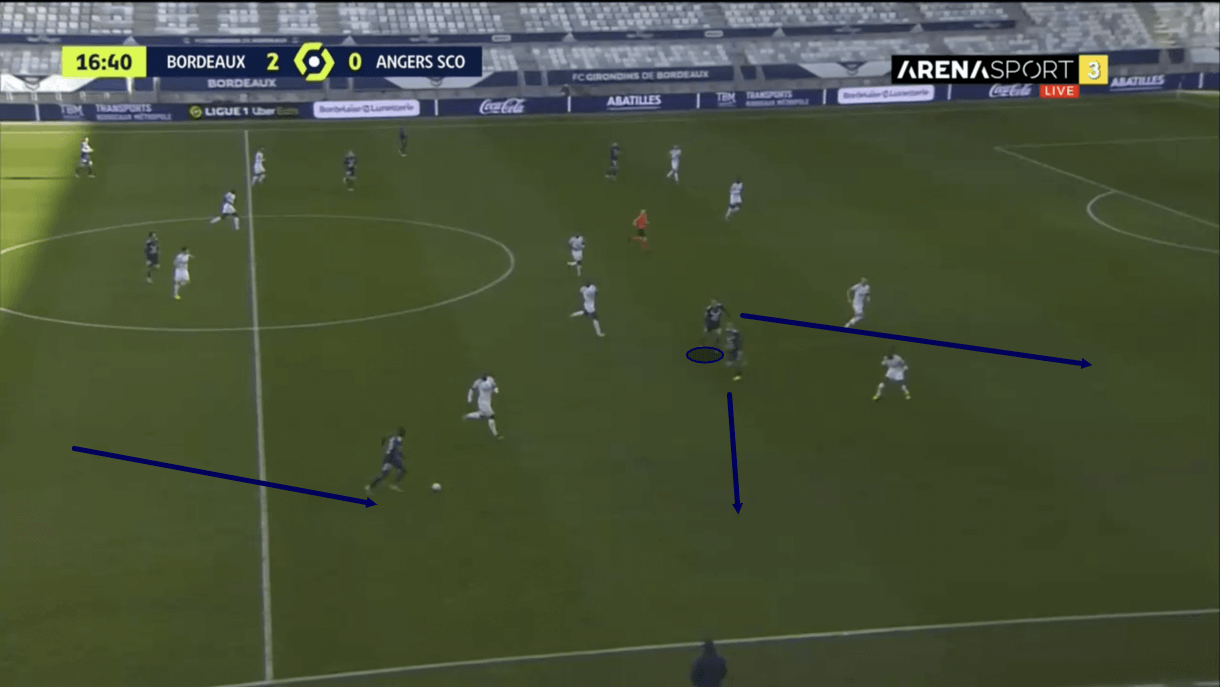
This movement from the centre out to the wing is a common one for Ben Arfa to make, however, while this is a common tactic of Bordeaux’s, it’s not always practical. The image above shows us another example of this exact scenario. Still, from a different game, however, as the right-back gets set to play the ball to the winger, the left-back doesn’t vacate his position to open up space for Ben Arfa on this occasion, instead opting to stay where he is and this stifles Bordeaux’s plans, forcing right-back Youssouf Sabaly to turn and play the ball backwards.
As a result, we can see that this tactic is not as effective when the opposition defenders are not as quick to jolt out of the backline, instead, ensuring that they focus on the incoming run from Ben Arfa in behind the defensive line. This may be one way that teams can prevent Bordeaux playmaker from hurting them via this specific movement.
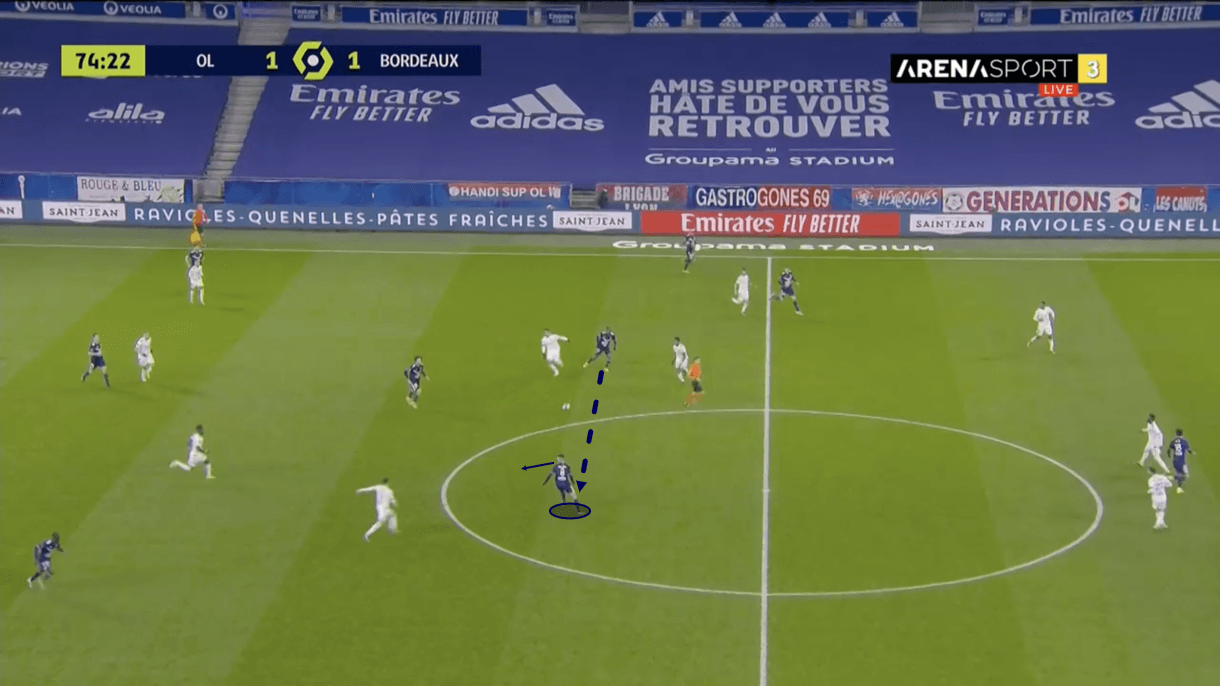
As we can see in this next image above, Ben Arfa is constantly scanning his surroundings off the ball to ensure that he is in the best possible position to receive a pass and to ensure that he has a clear mental picture of his surroundings to help his decision-making when he does receive the receipt.
Here, we can see that the 33-year-old is receiving a pass while situated inside the centre-circle once again. However, we can see that he is being closed down by one opposition player, who he has spotted by checking his left shoulder.
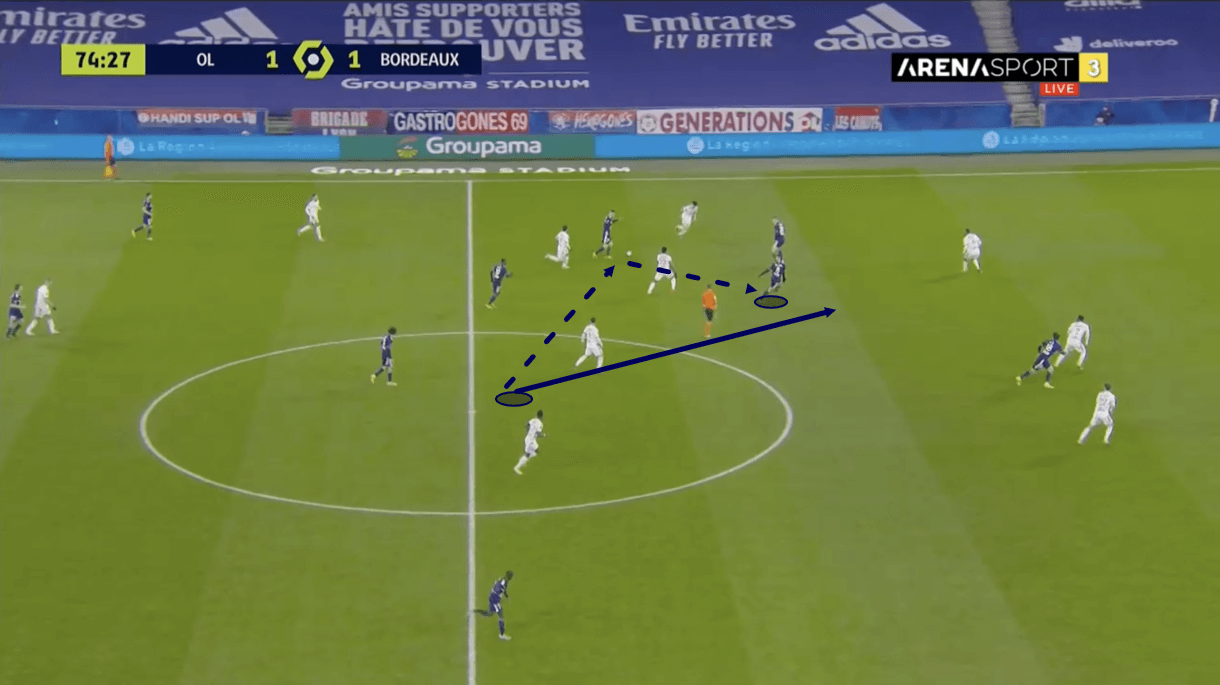
As a result, Ben Arfa is quick to release the ball after receiving it, playing a short through ball to a teammate who had found space in a slightly more advanced position as he received this pass. As the play moves on, we see that Ben Arfa managed to lose his marker and find more space further up the pitch, where he can get on the receiving end of another pass from the player he’d just passed the ball to.
In addition to finding himself in space, we can see that Ben Arfa has orientated his body in a position where he can take the ball on the half-turn, with the inside of his far foot, making it easy for him to turn and quickly set off on a dribble towards the opposition goal after taking the ball.
So, we can see from these examples, some of how Ben Arfa typically moves about off the ball, to find space on either wing or centrally in both advanced and deeper positions. He’s quick to spot space thanks to his spatial awareness and constant scanning. How he’s managed to exploit space has proven pivotal for his success with Bordeaux this season, as his ability to find space helps him make the most of his dribbling quality.
Dribbling
Moving on to his dribbling quality, Ben Arfa has been one of the most impressive ball progressors in Ligue 1 this term. He has made 10.41 dribbles per 90 this season – the second-highest number of dribbles taken on by any player in France’s top-flight, trailing only PSG attacker Neymar – and he has completed 57.05% of those dribbles – the 30th-highest dribble success rate of any Ligue 1 player this season.
While Ben Arfa has engaged in a very high number of dribbles per 90 in the league this season, he has also been relatively highly successful with those dribble attempts, indicating that perhaps it is wise of Gasset and his coaching team to exploit this element of the 33-year-old’s game as much as they do.
Ben Arfa has proven to be very valuable in terms of what he offers to Bordeaux as a ball progressor this season thanks to his dribbling quality. We’ll provide some analysis of examples highlighting how he has performed this role for his team in this section.
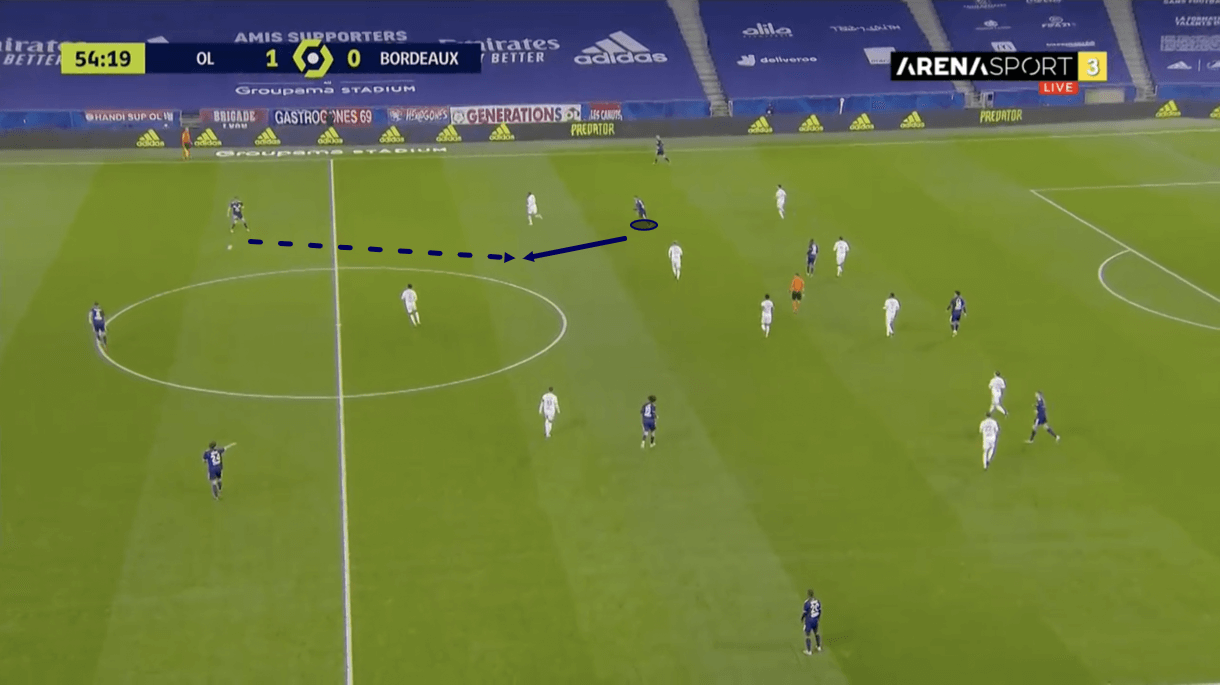
Firstly, the image above shows us an example of Bordeaux building into the opposition’s half of the pitch. They tend to form a back-three when building up, and Ben Arfa often performs a ‘connecting role’ between the backline and the forward line, as this image may suggest, as we can see him dropping more profound into the central third of the pitch, here.
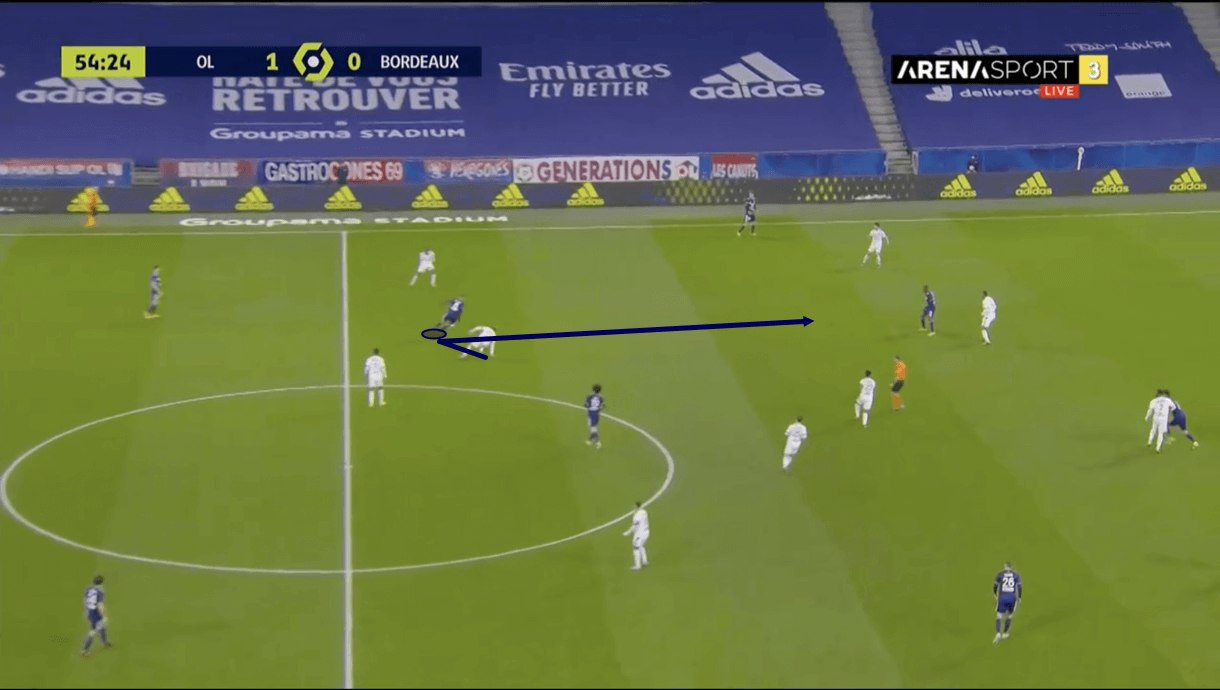
As the play moves on, we can see that the left-sided defender picked out the dropping Ben Arfa with his pass, who subsequently managed to wrong-foot the nearest opposition player via some quick feet and go on to carry the ball forward, driving Bordeaux into the final third.
The player’s agility, balance and speed all come in useful to help him successfully lose his markers as he did in this passage of play and carry the ball upfield, avoiding challenges along the way. This season, he’s managed to show that he has still got those skills in abundance despite his age.
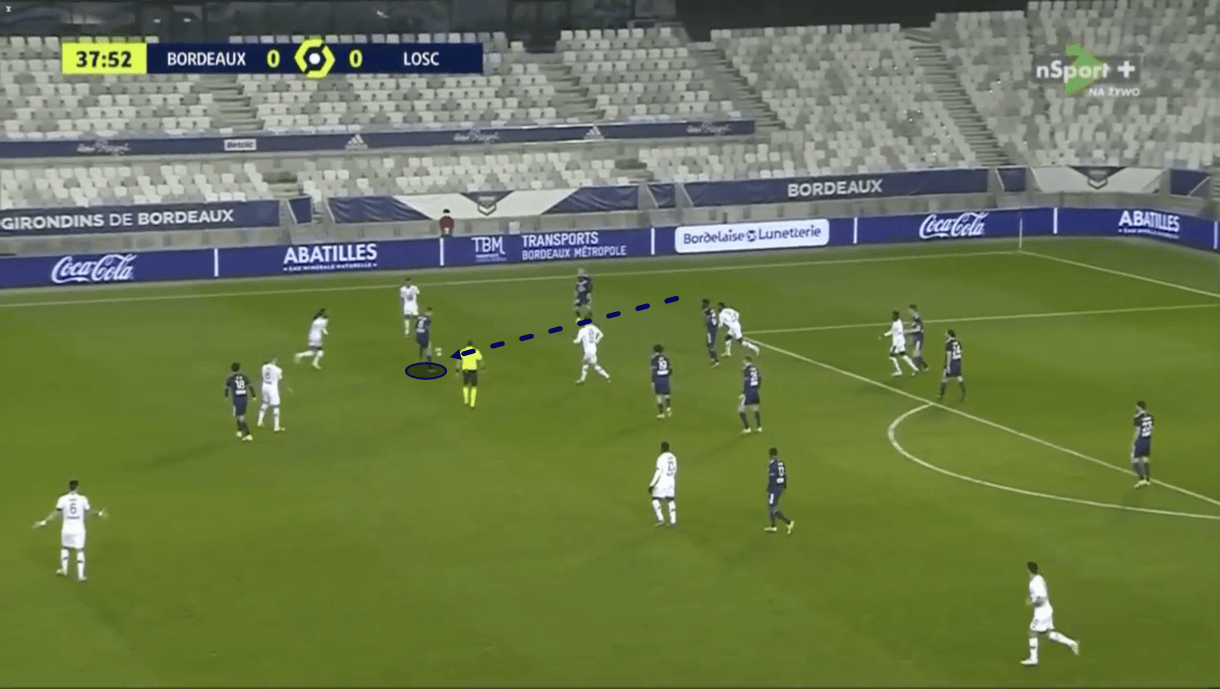
Ben Arfa’s dribbling quality is also useful for his side as an outlet to progress the ball upfield from even deeper positions – to kickstart counter-attacks or relieve pressure on the defence if the opposition has committed several players to the attack.
The image above shows us one such example where Ben Arfa picked up the ball deep inside his own half following a clearance from the backline. As he received possession, multiple opposition players began to close in on him. That was a regular thing to see in this game, particularly with Lyon seemingly deciding to try and cage Ben Arfa with players, and get them to close in on him as he received the ball.
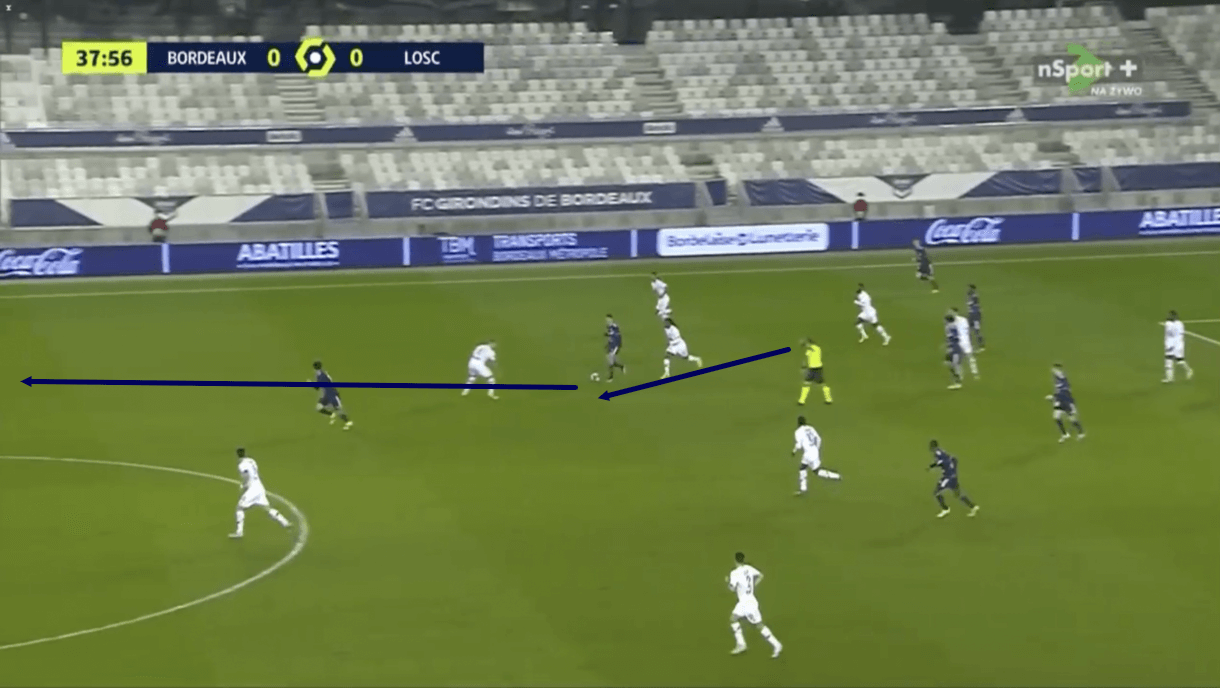
That was a successful strategy for Lyon a few times. However, on this particular occasion, Ben Arfa managed to pull off some impressive skill, twisting his way past opposition pressure, escaping the cage around him and going on to beat the next man that presented an obstacle to him, who we can see closing the attacking midfielder down.
This play passage provides us with a great example of how Ben Arfa provides support for his side in terms of relieving pressure and kickstarting counter-attacks. His dribbling quality is crucial in these situations, and he has proven capable of quickly turning defence into attack thanks to this skill.
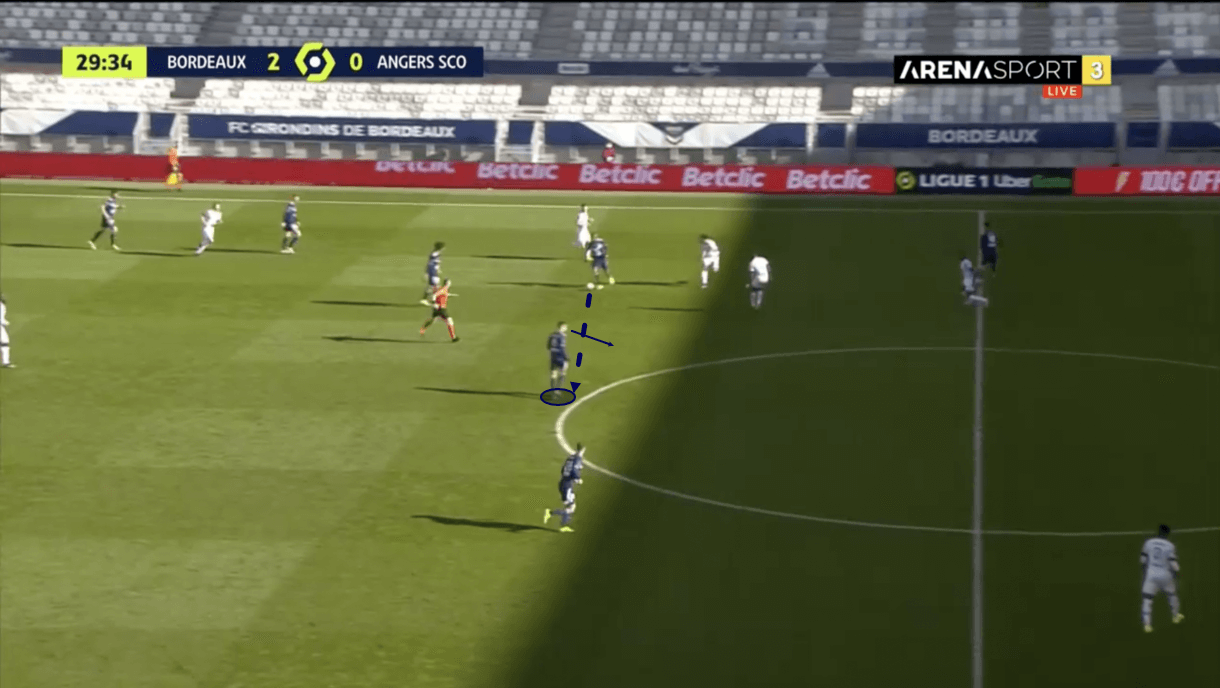
Lastly, another important element of Ben Arfa’s dribbling threat is how he pulls opposition players towards himself via his dribbling, creating additional space for teammates as a result. In the image above, we can see Ben Arfa preparing to receive the ball in the centre of the pitch, as he often does, checking his shoulders to ensure that he has as much space as he thinks and gives himself an idea of where he should carry the ball.
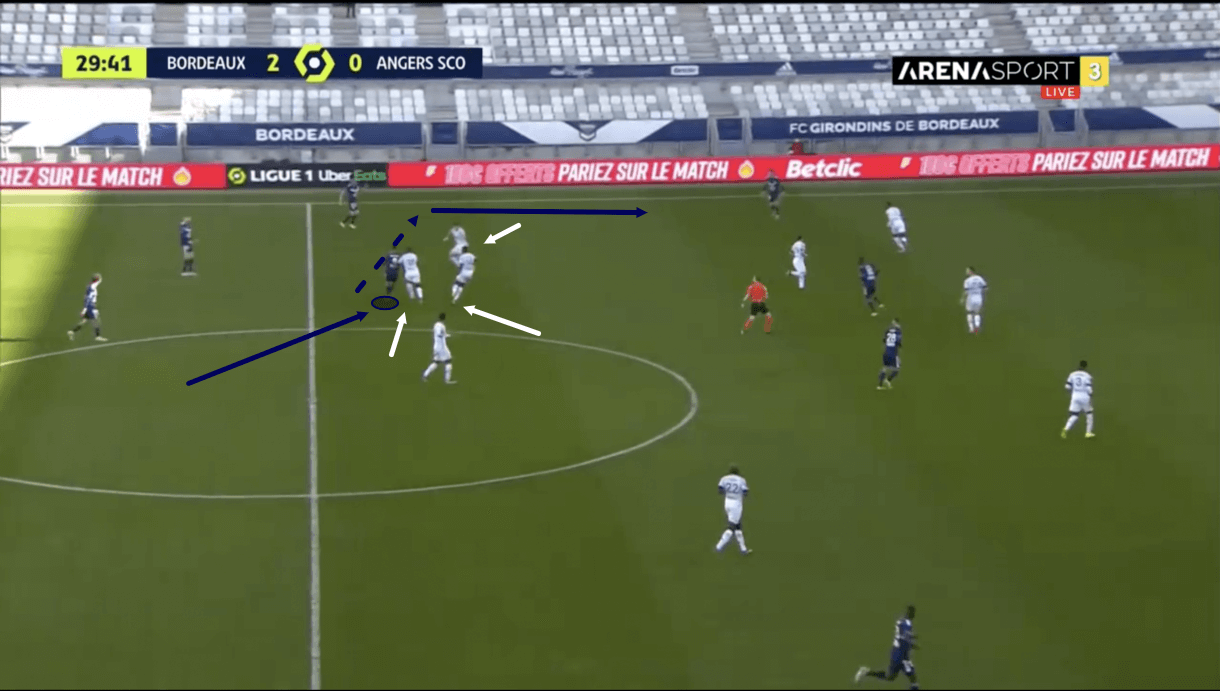
As this passage of play unfolds, we see that Ben Arfa opted to carry the ball out towards the left-hand side of the pitch and as he does so, he attracts pressure from three opposition players.
This creates space for his teammates out on the left-wing, one of whom he manages to find with a through ball. Largely thanks to the space created via Ben Arfa’s dribbling, this player was then able to carry the ball into the final third.
So, we can clearly see several benefits for Bordeaux from Ben Arfa’s dribbling ability. Still, ultimately, you could say that it all boils down to the playmaker, proving that he can be a top-quality ball progressor this season.
Passing
This next section will touch on Ben Arfa’s passing from the 2020/21 campaign. Firstly, we’ll feel on the Bordeaux men through balls.
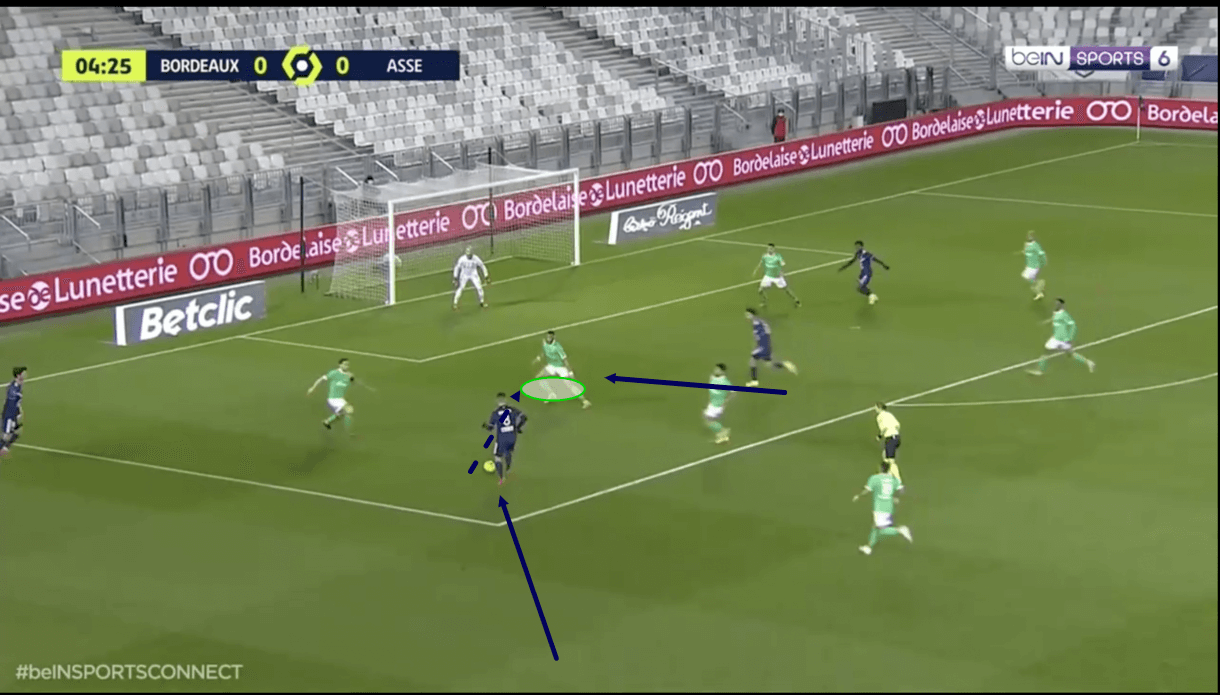
The image above shows us an example of one occasion where Ben Arfa carried the ball up the left-wing and into the opposition penalty area. As he does so, he spots a teammate making a run across the face of goal, while another teammate can be spotted towards the back post. Ben Arfa opts to play a through ball towards the front seat to meet that runner. However, the pass was ultimately intercepted.
Ben Arfa hasn’t played a great deal of through balls this season – 1.12 per 90 – while he has a poor through ball success rate of just 25%. So, with that low success rate in mind, perhaps it’s not a surprise that in contrast to his dribbling, which lots of importance is placed upon within Gasset’s system, Ben Arfa’s through balls haven’t been emphasised very heavily.
One thing to note about how the playmaker tried to pull off this attempted through ball, was that he disguised his intention of playing the ball towards the runner at the front post, initially lining up like he was planning to send the ball to the back post, before attempting to catch the opposition off guard and slip the ball through.
Ben Arfa often looks to disguise his passes like this, particularly inside the final third; however, the ball was well-read on this particular occasion.
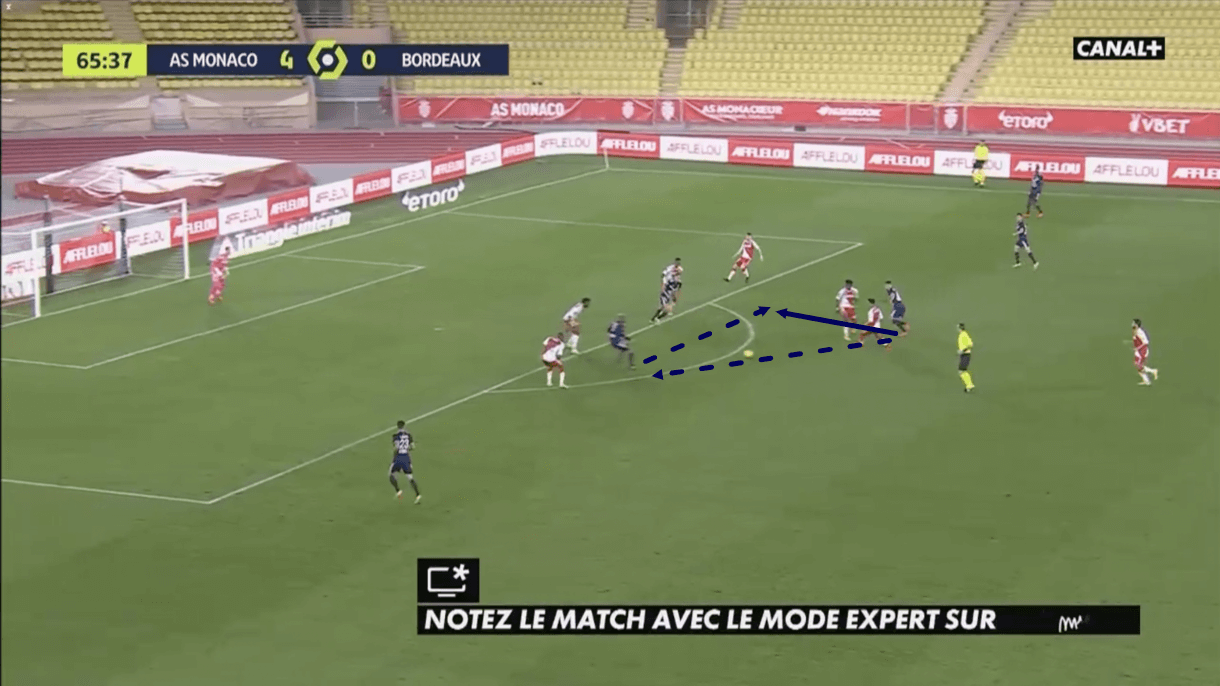
Rather than looking to play balls to runners in behind the opposition’s defensive line, Ben Arfa generally prefers to link up with his teammates via quick, short passes in and around the penalty area, as we can see in this next image above.
Here, Bordeaux’s centre-forward dropped off from the defensive line to link up with Ben Arfa, who had just carried the ball forward from a deeper position. As the playmaker passed the ball to this player, he continued his run on, to receive a return pass and attempt to break through the opposition’s defensive line.
This may highlight how Ben Arfa prefers to link up via short passing moves in advanced positions instead of playing the final ball in behind the defensive line.
Conclusion
To conclude this tactical analysis piece, in the form of a scout report, it’s clear that Ben Arfa’s ball-progressing quality and his ability to find space off the ball via intelligent movement have proven to be the most impactful elements of his game at Bordeaux this season.
There are some negatives to his game, such as his low through ball success rate and the fact that he also offers Bordeaux very little defensively, having made fewer interceptions and engaged in more occasional defensive duels than any other outfield Bordeaux player, per 90, during the 2020/21 campaign.
However, despite those drawbacks to his game, he has undoubtedly been a key man for Les Girondins this season thanks to how much he offers his team via the aforementioned positives.





Comments